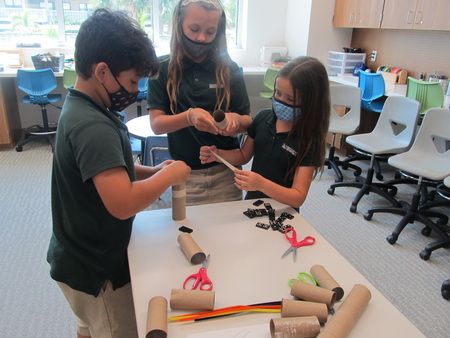

Third Grade Force and Motion Unit: How Do things Move?
Source/Author: Jennifer Hobbs, Third Grade Teacher and Raffi Darrow, Ebytes Editor
May 28, 2021
Third graders recently wrapped up a months-long interdisciplinary force and motion investigation project highlighting physics and STEAM skills. Teachers introduced the unit with a driving question: “How do things move?”
Students started by determining what they already knew about force and motion by creating a mini marble run. They were challenged to make a marble move from one side of a table to the other without pushing it. They viewed examples of Rube Goldberg machines made by Shorecrest students and others. With specific constraints in place and supplies such as dominoes, TP rolls and pipe cleaners, students got to work in teams and recorded their marbles with iPad devices. They made QR codes so others could watch videos of their “mini-Rube.” These exercises had the students thinking about acceleration, deceleration, leverage, advantage, speed, increase, and decrease.
Next, they put words to their skills through a rap about Newton's laws of motion. They also watched a PBS video that described simple machines such as the lever, the inclined plane, the wedge, the pulley, the wheel and axle, and the screw.
At the end of the first week, the classes regrouped to discuss the findings of their work, the types of simple machines, and what they had learned so far. Students were eager to practice their new skills outside on the playground where they explored gravity, friction and Newton's three laws of motion.
The second week of the unit led to Shorecrest’s Maintenance shed to meet with Dave Sharlow, Director of Operations. He shared information about how simple machines relate directly to the work done and tools used by his team. Third graders were astonished at some of the handmade tools that preceded so many of the electric tools that are used today. Mr. Sharlow showed the students how easy it can be to lift a golf cart with just a concrete block and a long piece of wood that he used to make a lever. The field trip continued when students searched campus for simple machines. They used Book Creator to demonstrate what they had found.
The week ended with an uproarious tug of war competition. Classes battled it out on the Charger Commons Greenspace, first with their shoes on and then with their shoes off, to see how force, motion and friction related to each other. Mrs. Hobb's class was victorious! And of course they learned a friction song.
Week three was a motion & design unit about forces that impact how things move - wheels and axles, speed, velocity, and acceleration. Students used K'nex to create cars to test force, motion, friction and load-bearing ideas. They put together a prototype car they expected to move over 100 cm. Once the cars were tested, they tried different surfaces to understand more about friction, slopes and inclines to add even more depth.
Students had fun exploring the relationship between a lever and fulcrum with a Pop-fly Challenge. They used a yardstick set up like a teeter-totter with a cup taped to one end to launch ping pong balls. When the location of the fulcrum under the yardstick changed, the distance the balls traveled changed too!
Next the children received a lesson on aerodynamics and flight. Mrs. Dominique Hamm, Director of Auxiliary Programs and the daughter of a former pilot, had so much information to offer about airplanes and the science that enables them to fly. It was pretty astounding to learn about the forces that allow these gigantic machines to successfully and gracefully carry us through the air. Mrs. Hamm taught lessons about drag, lift, gravity, and thrust. Students applied their knowledge by making and flying paper airplanes.
“As luck would have it, by the time we were ready to take our airplanes outside to test them, the wind picked up. Oh boy… did we see some flying!! The children had a blast!” the teachers shared.
“As luck would have it, by the time we were ready to take our airplanes outside to test them, the wind picked up. Oh boy… did we see some flying!! The children had a blast!” the teachers shared.
The Chargers revisited Rube Goldberg machines with their newfound knowledge. They applied concepts of velocity, momentum, speed, friction, gravity, and resistance. Each group created a chain reaction machine with a goal - such as stapling a piece of paper, filling a plate with a snack, or making a car drive through an arc.
On Friday the children learned that all objects resist motion - known as inertia - though not all objects have the same amount of inertia. To prove this point, the children constructed towers of blocks with index cards in between the blocks. They took turns pulling out the index cards to see how the blocks would react. They repeated the experiment with plastic cups.
Other projects and presentations included LEGO simple machines with Katy Deegan, Lower School Technology Coordinator, and learning about gears and tires on bicycles with Eric Johnson, Shorecrest parent and technician.
Finally, students used their newfound knowledge of how things move to help others. Through the design thinking process, students designed a possible solution to help someone with a disability or limitation.
Look for simple machines with your students in your daily lives. They are everywhere!
Find Force and Motion photos here.
Find Force and Motion photos here.
























